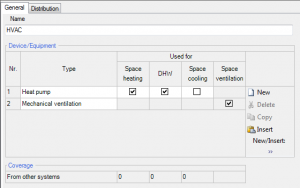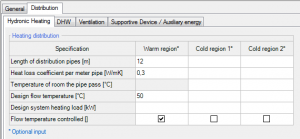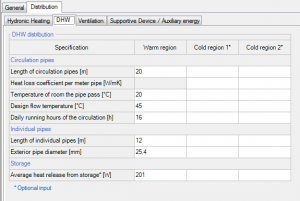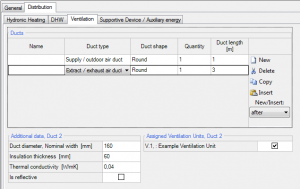Passive2:HVAC
General
The HVAC devices for the building are defined in this section. This means usage and also energy/work distribution if multiple devices are used for the same task. For a list of possible devices see the HVAC database and for information about the needed input of the respective device, see this page.
Distribution
In the Distribution tab, the distribution of the generated heating, cooling, DHW, and ventilation is defined. The heat losses due to pipes and ducts are taken into account for the final calculation.
Hydronic heating
These inputs are only required, if the Hydronic Heat distribution is accomplished by pipes. For the estimation of the heat loss, data about the pipe length, geometry, its insulation and the temperature difference between inside fluid and outside is necessary. The heat loss coefficient has to be calculated by a separate tool which is implemented on the GUI of WUFI.
WUFI distinguishes between warm regions and cold regions. In warm regions the indoor temperature is used for the calculation of the temperature difference, whereas for the cold region the temperature has to be defined.
DHW
The DHW distribution is very similar to the Hydronic Heating distribution. Additional information about the running hours of the circulation are required. Usually the DHW circulation is running 24 hours per day, apart from single family houses, which are running around 8-12 hourse a day.
Furthermore, the length (sum) and diameter of individual pipes need to be entered. The pipes are starting from the circulation and usually end at the water tap.
In the case where no circulation system is used, only the sum of the individual pipes should be entered and calculated from the hot water tank/source to each individual tapping point.
The Design Flow Temperature must always be entered, regardless of recirculation or not.
Ventilation
The distribution of the ventilation is accomplished by ducts. Each duct has to be assigned to one or more ventilation unit(s). The duct length, geometry and insulation influences the efficiency of the ventilation system. Unlike other components it is not necessary to create an assembly for the pipes as the thermal resistance is only estimated by the insulation.



